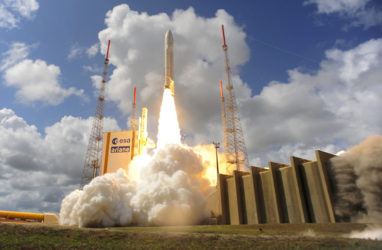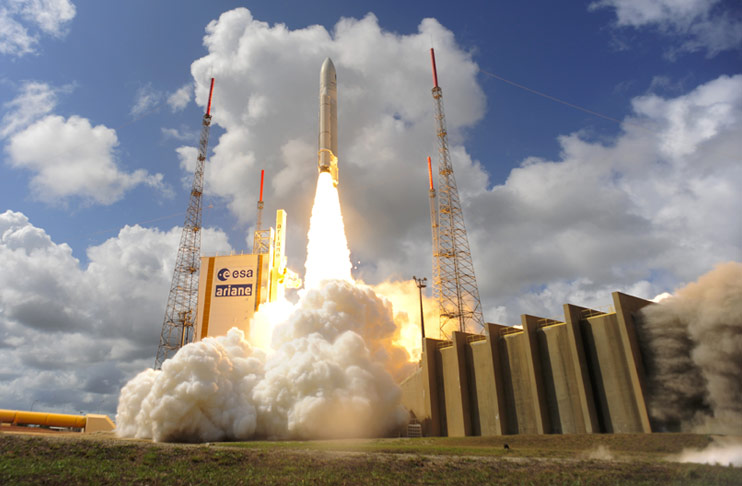Techtextil and Texprocess present ‘Living in Space’ in cooperation with ESA and DLR. Nutrition, mobility, fashion and living: technical textiles make settlements in space possible

Beam me up, Scotty: a large amount of material has to be transported for a journey into space – and technical textiles account for a large proportion of them. Examples of the parts and products in which they are to be found will be on show at the ‘Living in Space’ exhibition during this year’s Techtextil and Texprocess (9 to 12 May 2017), which has been organised by Messe Frankfurt in cooperation with the European Space Agency (ESA) and the German Aerospace Centre (DLR). Among the exhibits to be seen are materials and technologies from Techtextil and Texprocess exhibitors in a ‘Material Gallery’, architecture for space by Ben van Berkel, space-inspired fashions and an original Mars Rover. And – even without having completed a dizzying astronaut training programme – visitors can take a journey through space to Mars via virtual-reality glasses.
“At the ‘Living in Space’ exhibition, Techtextil and Texprocess visitors can see examples of textile materials and processing technologies in an application-oriented setting. In cooperation with our partners and exhibitors, we have created an informative and entertaining area, the like of which has never been seen before at Techtextil and Texprocess”, explains Michael Jänecke, Brand Manager, Technical Textiles and Textile Processing, Messe Frankfurt. Given that technical textiles are to be found in almost every sphere of human life, the materials and processing technologies shown are oriented towards the ‘Architecture’, ‘Civilization’, ‘Clothing’ and ‘Mobility’ areas of application.
Ideal homes in space
Visitors can get an idea of how building in space could function at the ‘Architecture’ area curated by Stylepark architecture magazine. Lightweight construction and canopy specialist MDT-tex joined forces with star architect Ben van Berkel of the international UNStudio firm of architects to create a ‘Space Habitat’ especially for Techtextil. Comprising 60 individual modules, each of which is double twisted and under tension, the lightweight pavilion has an area of 40 square metres and consists of specially designed aluminium profiles covered with PTFE sheets. MDT-tex designed the fabric especially for the pavilion in an extremely light grammage without sacrificing its high-temperature resistance and technical properties.
Ultra-lightweight materials play a leading role in space travel because the lighter the space capsule’s load, the cheaper the transport. Reclining in comfortable seats, visitors to the Space Habitat can also travel to Mars using virtual-realist glasses; and at the same time, find out more about technical textiles and their processing in space.
High-tech fashion in orbit in Techtextil
No one likes to be too hot or too cold. Space-wear should not only protect the wearer from extreme temperatures; but also regulate their body temperature, drain off moisture and be durable and easy to clean. All the better, then, if it also looks good; as shown by the designs in the ‘Clothing’ segment of the exhibition. The ESMOD Fashion School from Berlin presents outfits made by students; within the framework of the ‘Couture in Orbit’ project (2015/2016); which was organised by ESA and the London Science Museum. Additionally, the POLI.design centre of the Politecnico di Milano (Milan University) presents outfits from the follow-up project; ‘Fashion in Orbit’ under the scientific supervision of Annalisa Dominoni and the technical supervision of Benedetto Quaquaro; in cooperation with ESA and garment manufacturer Colmar.
The Hohenstein Textile Institutes present two models from the Spacetex research project; within the framework of which astronaut Alexander Gerst tested the interaction of body, apparel and climate; under conditions of weightlessness during the ‘Blue Dot’ mission. In this connection, the model; ‘Nostalgia’ by Linda Pfanzler (Lower Rhine University) reminds the wearer of the earth with an integrated library of fragrances. The suits of the ‘Dynamic Space’ collection by Rachel Kowalski (Pforzheim University) contain electrodes that stimulate important muscle groups under conditions of weightlessness.
The outfits by Leyla Yalcin and Sena Isikal (AMD Düsseldorf) come from the ‘Lift off’ collection; created in cooperation with Bremen-based silver-yarn manufacturer Statex. They include a sleeping bag for astronauts made from silver-coated textiles; which can also be used as an overall and protects the wearer from electro-magnetic radiation. Thanks to the silver threads; another garment, a raincoat reflects light and stores the wearer’s body heat.
Material Gallery: fibres for space
In addition to the exhibits at the special exhibition; around 40 Techtextil and Texprocess exhibitors offer ideas for fibre-based materials; and processing technology suitable for use in space in a ‘Material Gallery’. For the ‘Civilization’ segment, they include spacer fabrics for growing vegetables; for ‘Mobility’ a carbon yarn, which was used to make a fairing for the solid-fuel booster rocket of the Ariane 6. The Material Gallery also shows fibre-composite structures made of carbon fibres; such as a robot arm, a whole-body suit that transmits the wearer’s movements to a 3D model in real-time; functional apparel textiles with flame-retardant, anti-bacterial and temperature-regulating properties, and membrane systems for ventilating aircraft.
Exhibits from ESA, DLR and Speyer Museum of Technology; including an original Mars Rover and space suits, make the exhibition an extraordinary experience. The exhibits are supplemented by impulse lectures by ESA experts for technology transfer throughout the fair. And, because satellites are assembled in clean rooms, Cleanzone; International Trade Fair and Congress for Clean Room Technology will be held on the exhibition area; (in Frankfurt am Main from 17 to 18 October 2017).

